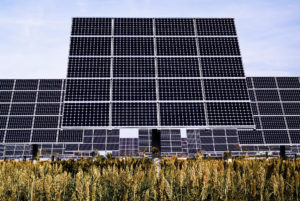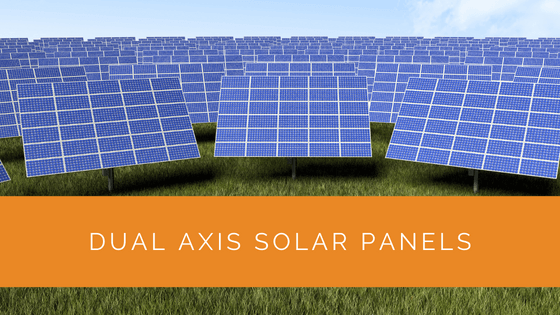Solar energy has existed for millennials. However, it is only at the turn of the 21st century that humankind learned how to harness it effectively. With structures like solar panels, sunlight is easier than ever to power up your space and appliances.
Most solar structures are static, i.e. they need to be installed in a location where maximum sunlight falls. This could pose a limitation, especially on days when clouds restrict sunlight. Fortunately, technological advancement has led to the creation of solar trackers that follow the sun’s position as it moves throughout the day.
A dual-axis solar tracker is a type of solar tracker that can help increase energy for your space by following the sun as it moves. Curious? Read on to find more!10%
Contents
- 1 Key Takeaways
- 2 The Principle of Dual Axis Solar Panels
- 3 Why Choose Dual Axis Solar Panels?
- 4 Configurations Available
- 5 Advantages of Dual-Axis Solar Panels
- 6 Disadvantages of Dual-Axis Solar Panels
- 7 Where is the Dual-Axis Solar Tracker Market Heading?
- 8 Case Study: Optimising Energy Production with Dual Axis Solar Panels
- 9 Expert Insights From Our Solar Panel Installers About Dual Axis Solar Panels
- 10 Discover the Power of Solar with Solar Panels Network
- 11 Summing Up
Key Takeaways
- Dual-axis solar panels are advanced solar trackers that increase energy efficiency by following the sun’s movement, providing up to 49.83% more power than static panels.
- They offer unmatched flexibility and accuracy in tracking the sun’s position, allowing them ideal for maximising energy output and addressing power capacity limitations.
- Despite their advantages, dual-axis solar panels have complex structures, shorter lifespans, and reduced performance in overcast weather. Still, their market is growing due to government incentives and increasing electricity demand worldwide.
The Principle of Dual Axis Solar Panels
These structures possess a solar sensor, a device used to locate the sun’s position. Alternatively, some dual-axis solar panels rely on GPS to accurately gauge the sun’s location. Upon receiving the sun’s signal, the solar panel moves accordingly and points towards the sun’s direction.
These solar trackers are paired with electric motors or hydraulic rams to ensure complete control. As the sun changes course, the solar tracker follows it to ensure maximum energy for your space.
Hybrid tracking systems are often recognized for their enhanced efficiency compared to other systems. They generate significantly more energy daily, making them popular for harnessing power.
One of the most significant advantages of the dual-axis solar tracking system is that it tracks the angular and east-west position of the sun. Irrespective of the sun’s position, you are guaranteed to receive an appreciable energy output.

Why Choose Dual Axis Solar Panels?
Traditionally, solar panels come in two forms – single-axis and dual-axis.
As the names suggest, single-axis panels can only move through a single plane, most commonly east-west. Dual-axis panels can cover both planes along which the sun can potentially move and are preferred for their north-south orientation.
The clear winner is dual-axis panels.
Single-axis panels are still valuable and a great option on a tight budget. They are also a better alternative to static panels that produce lesser output.
However, an axis solar tracking system is perfect if you have the budget and aim to harness maximum energy for your space. Not only is it more accurate, but it is also more precise and efficient than other solar trackers on the market.
Configurations Available
Sunlight is one of the most important sources of renewable energy. It also found reliable use to harness the power and replace fossil fuels in the long run. Hence, investing in an effective dual-axis solar tracker is crucial.
Here are some configurations for these devices based on changing the position of the tracker:
Manual
Usually done in countries with low labour costs, this method involves dedicated personnel changing their position throughout the day. They are asked to manually direct the panel’s position to the area receiving maximum sunlight.
Passive
These structures utilise the services of a bulb of liquid. The bulb gets heated when sunlight falls on it, and the liquid evaporates. This process expands volume, pushing the solar tracker towards the sun.
Active
Active trackers require electric or hydraulic motors to adjust the tracker’s position. These devices use light-dependent resistors as sensors. If there is a difference in output, it will generate error signals.
![]()
Advantages of Dual-Axis Solar Panels
There are multiple reasons, including the government’s initiatives to promote solar energy and subsidiaries. But what makes them so unique from other solar energy-harnessing options?
- They possess an unmatched degree of flexibility, allowing them to change course as per the sun’s position and produce more energy.
- Renewable source of energy with solar arrays trapping sunlight and saving costs
- Low maintenance costs in the long run; the panels require essential maintenance like regular cleaning
- A high degree of accuracy in tracking the direction of the sun
- Follow the sun constantly without losing track, ensuring consistent energy to power up your space throughout the day
- Installation is easy, and the devices do not take up significant space, allowing you to position them in a place where they can work uninterrupted
- The lower payback period on investment
- It is ideal for areas that hinder solar productivity with uneven structures that prevent sunlight from reaching static solar panels effectively
Dual-axis panels can also help address the limited power capacity in your area. They work on clean, pollution-free energy to produce better outputs than other solar panels.
![]()
Disadvantages of Dual-Axis Solar Panels
Although seemingly perfect on paper, dual-axis solar panels are synonymous with certain limitations. Some of these limitations include:
- Complex structure and application, making these devices prone to frequent glitches
- Relatively shorter lifespan with lesser reliability than traditional solar panels
- Performance impacted in overcast or cloudy weather
One can resolve most issues by contacting a professional handling dual-axis solar panels.
Where is the Dual-Axis Solar Tracker Market Heading?
Solar trackers are gaining popularity and are increasingly adopted in commercial and residential complexes. The growth of the market is driven by some factors, like:
- Growing demand for effective solar trapping using solar arrays inside panels
- Government subsidiaries and policies that offer tax benefits and other advantages for individuals investing in renewable energy, like solar trackers
- Electricity demand in many parts of the world
Case Study: Optimising Energy Production with Dual Axis Solar Panels
Background
A manufacturing facility in Kent aimed to cut operational costs and reduce its carbon footprint by integrating renewable energy solutions. With ample space for solar installations, the company considered dual-axis solar panels to maximise energy capture and meet variable energy demands consistently.
Project Overview
The project’s objective was to install a solar PV system capable of tracking the sun’s movement throughout the day, thereby maximising energy production. This system needed to meet the facility’s variable energy requirements and provide a reliable, sustainable energy source.
Implementation
- Site Assessment and Feasibility Study: Evaluated sunlight exposure, shading potential, and the structural capacity of the installation area.
- System Design and Engineering: Developed a custom dual-axis solar panel system with GPS-based solar sensors and hydraulic motors for precise tracking.
- Installation and Commissioning: Set up the system with minimal disruption, strategically placing panels to avoid shading and maximise sunlight exposure. Conducted thorough testing and calibration to ensure optimal performance and safety.
Results
- Enhanced Energy Production: The dual-axis system increased energy output by approximately 47% compared to static panels.
- Cost Savings: Achieved substantial savings on energy costs with a return on investment within five years. Qualified for government incentives, further offsetting the installation costs.
- Sustainable Operations: Contributed to the facility’s sustainability goals by reducing its carbon footprint and aligning with environmental standards.
Summary
This case study demonstrates the effectiveness of dual-axis solar panels in optimising energy production for commercial facilities. The installation in Kent led to enhanced energy efficiency, significant cost savings, and a reduced environmental impact. The success of this project highlights the value of advanced solar tracking technology in achieving sustainable energy objectives, making it a worthwhile investment for businesses aiming for energy independence and environmental responsibility.
Expert Insights From Our Solar Panel Installers About Dual Axis Solar Panels
Dual-axis solar panels are game-changers in the solar industry, offering a sophisticated solution for maximising energy capture. They track the sun’s path more accurately than fixed or single-axis systems, making them ideal for regions with fluctuating sunlight throughout the day.
Lead Solar Engineer
The precision of dual-axis solar trackers in following the sun’s movement allows them to generate up to 50% more energy compared to static panels. This efficiency makes them a wise investment for those looking to optimise their solar output.
Senior Installation Specialist
While dual-axis systems are more complex and initially more expensive, the long-term benefits, including increased energy production and reduced grid dependency, often outweigh the upfront costs. They are particularly valuable in commercial applications where energy demand is high.
Solar Technology Consultant
Discover the Power of Solar with Solar Panels Network
Are you navigating the world of solar installations? Look no further than Solar Panels Network, the UK’s trusted partner in harnessing the sun’s potential. Our dedication goes beyond just installations; we’re on a mission to transform how homeowners and businesses across the UK perceive and utilise energy. By choosing us, you’re reducing your carbon footprint and making a smart financial move that promises savings for years ahead. Contact us today and embark on your solar journey.
Summing Up
With fixed solar panels in most homes, the need for dual-axis panels is still prevalent. Individuals will switch soon, given that the technological landscape will evolve and dual-axis panels will adapt.
Despite single-axis panels occupying the lion’s market share, these devices show no sign of slowing down with their mammoth market value. The only factor holding their popularity surge is the complex mechanism. Once there are better ways to address the system’s complexities, dual-axis solar panels will witness more popularity.
So, if you plan to get one, there is no better time than today!
About the Author
Solar Panels Network stands at the forefront of solar energy solutions, driven by a team of seasoned solar engineers and energy consultants. With over decades of experience in delivering high-quality solar installations and maintenance, we are committed to promoting sustainable energy through customer-centric, tailored solutions. Our articles reflect this commitment, crafted collaboratively by experts to provide accurate, up-to-date insights into solar technology, ensuring our readers are well-informed and empowered in their solar energy decisions.

